Abstract
Foreign language teaching is linked with an enormous number of teaching methods and approaches. The paper presents the research carried out with the focus on those methods in which music is applied as the main means or an additional one in the process of teaching of foreign languages. Since its beginnings, the methodology of foreign languages has been concentrating on bringing out effective methods, approaches, ways and forms enabling effective acquisition of a foreign language as a means of communication. The main source of inspiration was the method called sugestopedy; this method is presented and evaluated. The second part of the paper presents the results of the research focused on teachers and learners of foreign languages – the two main issues of the research were those forms of work used by teachers of foreign languages, which apply music during the classes, and learners´ opinions on applying music in classes of foreign languages. The research results can lead to self-reflections made by foreign language teachers, and they can be inspiring for thinking about procedures applied in the teaching process.
Keywords: Musicforeign language learningmusical skillsmethod
Introduction
Recent years are typical of an unprecedented increase in commercial use of music in our every-day life. The frequency of listening to music is growing, and the ways of listening to music are quite varied thanks to technological progress. Music is present everywhere – in venues of cultural and sports events, in public means of transport, shopping centres, hotels, restaurants, surgery rooms and many other places. Listening to music is timeless – pregnant ladies sing or listen to music (and this music has an impact on the not-yet-born child´s development already), music is played when the very last farewell is expressed at funerals. Human beings are in an active or passive contact with music nearly every day. At this point it is necessary to mention the issue of individual cognitive differences between people – every human being perceives music in his/her own specific way, which results from social differences and differences in age, qualifications, etc.
Methods in foreign language teaching
The issue of music will be now presented in relation to teaching of foreign languages, especially in relation to teaching methods, which use music. The term “method“ can be explained as “a way leading somewhere“ because it comes from a Greek word
The theory of foreign language teaching as a scientific discipline uses findings from other scientific fields, especially from linguistics (and its sub-disciplines – psycholinguistics, sociolinguistics or neurolinguistics), psychology and pedagogy. The right choice of the methods is essential for reaching the goals of the teaching process. The methodology of foreign language teaching has to be viewed from two angles – from the angles of two kinds of methodology:
Methodology in the strict sense of the word refers to specific teaching processes, describes them and gives guidelines for their planning, it also mentions teaching materials. (Krumm, 1981; Freudenstein, 1970)Methodology in the broader sense of the word includes also factors influencing the choice of the issues to be taught. (Mackey, 1965)
From the following picture, it is clear that a lot of factors have an impact on the methods used in foreign language teaching.
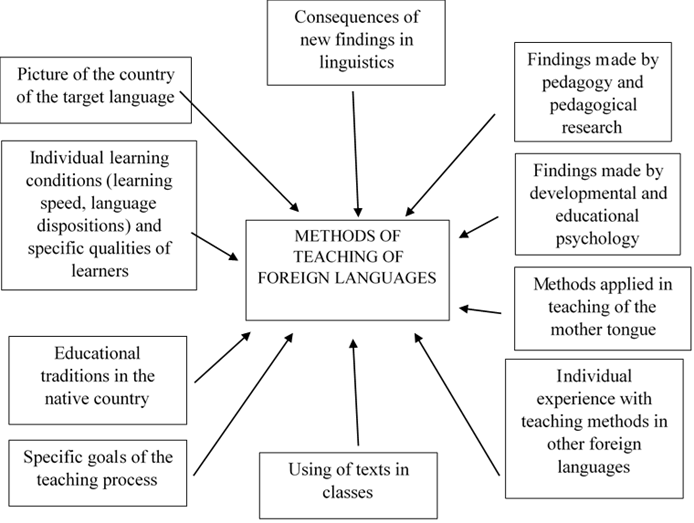
The current methodology of foreign languages is based on communicative and inter-cultural methods, which require teachers of foreign languages to be at nearly the same level as native speakers and thus to be models and mediators of using the given foreign languages. To enable a better understanding of the conditions of foreign language teaching in Central Europe and post-communist countries, a short presentation of the context of developmental tendencies in foreign language teaching will be made, with a focus on the use of music in the teaching process. It is important to realize that the development of foreign language teaching in our territory was rather different from the development in the western world, which was determined by the political development mainly in the second half of the 20th century.
Firstly, it is important to explain the difference between “traditional” and “alternative” teaching methods. The “traditional” ones are those which are commonly used by numerous types of (not only) Czech schools. These methods are stable, verified by practice and essential for a correctly working educational process. They have their irreplaceable position at Czech schools. Alternative methods were coming into being simultaneously with the process of establishing of alternative schools. Maňák (2003, p. 105) labels the term of an alternative teaching method to such teaching procedures thanks to which educational objectives are reached mainly on the basis of the learners own work, their thinking processes and their own ways of solving of problems. The characteristic features of these methods are presented by Maňák (1997, pp 12 – 13) in the following way:
learners´ positive approach – learners enjoy the teaching process and are self-confident,
individualisation – learners themselves decide on their working styles on the basis of their abilities and interests,
various activities – dialogues, discussions, problem solving, project work, dramatization, role-playing, creative playing, creative writing,
variability – acceptance of diversity and peculiarities of personalities,
freedom – a non-directive approach of the teacher, a nice school atmosphere and climate, a possibility to express one´s own opinion and then the ability of being responsible for one´s own activities and decisions,
cooperation – cooperation between learners, support to the others, argumentation, defence of one´s own opinions, acceptance of the others´ opinions,
constructive approach – a learner discovers, communicates, finds out, combines and compares,
meaningfulness and comprehensibility,
playfulness,
health aspect
global conception – the learning material is integrated into thematic blocks, through which understanding of mutual connections and dependence can be reached.
Both traditional and alternative methods have their positive and negative aspects. The biggest positives of these methods are a non-traditional learning environment, involvement of senses and physical activities (through which the centre of memory in the brain is activated) and working in small groups. The main drawbacks of alternative methods are their demanding methodology and demanding creation of suitable learning materials, and their insufficient verification in practice and methodology. Despite these drawbacks it can be claimed that also alternative teaching methods can enrich the process of foreign language teaching at schools and that they can suitably supply the traditional teaching methods.
Methods in foreign language teaching with respect to music
Hendrich (1988, p. 257) mentions the fact that the contrast of two main conceptions, the synthetic and the analytic one, is evident in the whole historical development of the methodological tendencies in foreign language teaching. Hendrich´s synthetic conception refers to the grammar-translation method, whereas the analytic conception is labelled as the direct method.
At the end of the 19th century, the reformist movement appeared and resulted in applying so called direct method. One of the first representatives of this method was Wilhelm Viëtor. (Wilhelm Viëtor (1850 – 1918) was a German linguist belonging to prominent reformists of the end of the 19th century. He criticised the grammar-translation method for its teaching the alive language through means and rules of the already dead language. (Neuner; Hunfeld, 1993, p. 31) Viëtor called mainly for the development of learners´ language competences. His work “Der Sprachunterricht muß umkehren“ (1882) is essential for the development of the direct method.) The main principle of the direct method is the preference given to the spoken form of the language. Hendrich (1988, p. 261) claims that a foreign language must be learnt in the same way as the mother tongue is learnt by children, that means intuitively. Neuner and Hunfeld (1993, p. 35) add to that the mother tongue has to be excluded from the teaching process. This exclusion is thus applied also to the use of dictionaries and translation exercises. The direct method teaches the learners how to use every-day phrases, translations are replaced by illustrative presentations in the target language, grammar is taught inductively. The direct method is based on listening and oral performances. The involvement of music, mainly songs, is evident. A big drawback of the direct method was the fact that at the beginning of its development the technology was not sophisticated enough to make recordings of a good quality and thus usable in the teaching process. The direct method has developed into its numerous modifications, among which e.g. Berlitz´s method is worth mentioning. This method was named after its founder, Maximilian Berlitz (Maximilan Delphinius Berlitz (1852 – 1921) was an American teacher of the German origin. He established so called Berlitz language schools. The mother tongue is completely excluded from their classes, grammar is eliminated to the minimum, translations are not used. The phonetic sphere of the language is prominent. This method teaches foreign language in the same way as the mother tongue is acquired. (https://en.wikipedia.org/wiki/Maximilian_Berlitz)) , and its various variants have been used up to now mainly in the U.S.A.
A kind of revolution appeared in the 1970s when the communicative approach started to be applied and
The term of suggestopaedia was created from two words – suggestion (according to Petráčková, Kraus, 2001, p. 719 it refers to inspiration, captivating action, impact on somebody´s thinking) and pedagogy, which is science on an intentional and systematically organized activity which forms a human being´s personality. (Petráčková, & Kraus, 2001, p. 576). The Lexicon of Pedagogy says that suggestopaedia uses knowledge and experience gained through suggestion to make learning easier. (Průcha, Walterová, Mareš, 2013, p. 236) Suggestopaedia came into being in the 1970s. Georgi Lozanov (Georgi Lozanov (1926 – 2012) was a Bulgarian pedagogue and psychologist, who in 1971 published the theoretical principles of suggestopaedia. Lozanov specialized also in neurology, he did research into sleeping and hypnosis. He also focused on researching into memory and he came to the conclusion that the ability to remember a world of a foreign language is different from the ability to use it actively. Lozanov also carried out research into the brain activities during various phases of suggestopaedic teaching process. ) , a Bulgarian psychotherapist, is considered to be its founder. There are four main principles of suggestopedia:
To remove inhibitions which limit spontaneous communication and to make learners relaxed. Mothejzíková (1993-94, p. 248) refers to Lozanov and other psychologists who claim that only 5 – 10% of our mental capacity is used, so the limitations have to be removed.
In the process of learning foreign languages both the cerebral hemispheres have to be activated. Lozanov supported the opinion of the 1970s – the language centre is in the left hemisphere; the right hemisphere is the centre of creativity.
All paralinguistic means, such as gestures, mimes and non-verbal, irrational or unconscious manifestations should be activated and used by learners.
To create a non-typical learning environment, i.e. to teach foreign languages in classrooms equipped with comfortable armchairs, decorated with pictures and then dominated by music and the teacher´s voice.
Mothejzíková (1993-94, p. 249) mentions three basic building stones of the suggestopaedic method of teaching – music, teacher and language. Music evokes our emotions, feelings, and reactions. A type of music, which evokes psychical relaxation and slows down body processes is convenient for the suggestopaedic way of teaching. The most convenient is slow baroque music played by string instruments, which works as a catalyser of saving knowledge in the long-term memory. According to Jäncke (2012, p. 203), the most convenient are the following pieces of music: “Wassermusik” by Georg Friedrich Händel, or “Largo-Sätze” by Johann Sebastian Bach. Speaking about applying music in foreign language teaching, Lozanov uses the term of “concert pseudo-passivity“, which can be defined as a kind of music background which makes learners more relaxed. Mothejzíková (1993-94, p. 250) considers this as being an optimal condition for foreign language teaching, because fear, tension, inhibitions and other negative feelings are eliminated, and concentration is increasing. The goal of Lozanov´s method is to use music for stimulating cerebral processes similar to relaxation or meditation, with the help of which it is possible to broaden thinking and open it for new perceptions. The method of suggestopaedia can be applied only when human beings are relaxed and calmed down. Then both the hemispheres can get activated and learners can better absorb new knowledge. It is rather problematic for people to calm down in the current hectic conditions. Therefore, it is nearly impossible to apply this method at Czech primary and secondary schools.
The teacher plays a big role in foreign language classes in which the suggestopaedic method is applied. S/he is a connecting unit between learners and the given language. A teacher must be a respected and emphatic authority, a reliable source of knowledge, and s/he should be able to motivate students and increase their self-confidence. Artistic elements are important for this type of the teaching process. In this connection we can mention e.g. integration of drama in education, and using of so called peripheral learning when as much learning material as possible is on display in the classroom for the purpose of decoration and strengthening of memory. All the learning material is presented in the form of dialogue. The method of suggestopaedia evoked both positive and negative reactions. The biggest problem, which is often mentioned, is memorization, automation and assimilation of the presented material. Mothejzíková (1993-94, p. 251) mentions that suggestopaedia is criticised mainly because of the following facts: It applies para-psychological techniques, which are harmful for mental health, and it is applied in an exclusive environment and under highly artificial conditions which are completely different from authentic situations. Another problematic issue linked with suggestopaedia is its pseudo-scientific feature; the principal procedures were not applied during the research, which was mentioned by some experts, e.g. Lukesch (2000), Mandl a Renkl (1993), Dieterich (1987) or Edelmann (1991). Using all the senses and all the kinds of memory in the process of learning foreign languages is highly recommended by the present methodology of foreign languages. Therefore, the method of suggestopaedia can be quite inspiring.
Since the 1980s the term of
The following table presents a summary of the above mentioned methods of teaching of foreign languages with comments on their applications of music.
There are numerous methods of foreign language teaching. This chapter focuses merely on the methods, which apply music either as the main means or as an additional type of materials. It can be claimed that an ideal and universal method of foreign language teaching actually does not exist. The methodology of foreign language teaching has been involved in looking for effective methods, procedures, ways and forms of foreign language acquisition since its beginnings. There is still a question whether it is possible to develop an effective method, which would be applicable in all the spheres of teaching of foreign languages.
Problem Statement
The main goal of the research was to compare the opinions of foreign language teachers with opinions of learners aged 10 (the fifth year of primary schools), aged 13 (the eighth year of primary schools and the third year of grammar schools) and aged 16 (the sixth year of grammar schools and the second year of secondary schools). The main focus was on using music in the methods applied by foreign language teachers and the following comparison of teachers´ and learners´ opinions. The data collection was realized in various towns of the Czech Republic. A method of quantitative research was applied – the questionnaires were distributed to teachers of foreign languages at primary, grammar and secondary schools and to pupils of these schools. 100 questionnaires completed by teachers and 1,062 questionnaires completed by pupils were processed in total. The comparisons of the answers given by the teachers and by the pupils were used for confirming or refuting one of our hypotheses concerning the way in which learners perceive the most frequently applied methods which make music involved in the process of foreign language teaching. The feedback given by pupils can be used by teachers for self-reflections and also as a kind of potential inspiration.
Research Questions
Before doing the research, the two following research questions were formulated:
Q1: Teachers of foreign languages at primary and secondary schools in the Czech Republic do not use music in its full scope in their classes. If music is used, then only for the reason of motivation.
Q2: Learners at primary and secondary schools in the Czech Republic would welcome a bigger involvement of music in their classes of foreign languages. Music is, in their opinion, only a marginal component of foreign language classes.
Q3: The feelings about the involvement of music in foreign language classes are not equivalent – the learners´ wishes are not the same as their teachers´ plans.
Purpose of the Study
Foreign languages can be taught only when applying some teaching methods. Since the process of foreign language teaching is based mainly on the learner - teacher interaction and some of the methods presented above are really based on a close cooperation between the teacher and learner, we decided to involved primary and secondary school pupils and learners into our research. We consider this approach as interesting from the point of the feedback given on the methods and activities applied in the teaching process.
Research Methods
The research into the teachers´ opinions was realized through a questionnaire poll, which was followingly quantified. The addressed teachers (100 in total, 62 females / 38 males) answered the question: ”Which aspect is, in your opinion, important when music is involved in foreign language teaching?“.
The same way of the data collection was applied in case of learners. The addressed learners (1,062 in total, 521 females / 541 males) answered the question: ”Which type of work is most often used by the teacher when s/he applies music in the process of teaching the foreign language?“. The question was asked in connection with teaching the first foreign language (English) and the second foreign language (German, Russian, French and Spanish). The results were quantified and Figureically illustrated with the Figures and shortly commented on.
Findings
The resulting findings are subdivided into two categories that of teachers and that of learners. The evaluation of the research findings is done through the Figures presented Figures below.
Teachers
On the basis of our research (see Figure
One very important aspect is very often ignored by Czech teachers – the aspect of practising supra-segmental linguistic phenomena, mainly practising the correct stress, melody, intonation, rhythm and tempo of the speech (Besedová, 2016, p. 659). A similar kind of ignoring exists also in case of applying music when presenting life and institutions and inter-cultural relations of the given language area – see also Besedová (2016, p. 659).
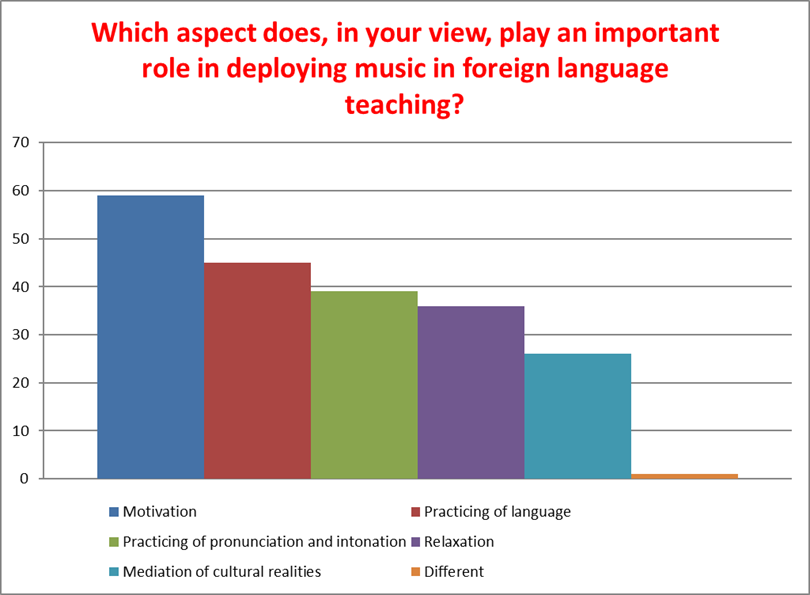
Learners
A learner is an integral part of the educational process; s/he is required to be very active. Rampillon (2000, p. 122) adds that pupils create their knowledge through discovering, comparing, connecting, communicating, trying, evaluating, refusing or confirming instead of just passively accepting and consuming. Therefore we think that learners´ opinions should be respected in the teaching process.
Within the framework of our research, learners were asked about their opinions on applying music in the process of teaching the first foreign language, i. e. English, in the Czech Republic. The research results are illustrated in Figure
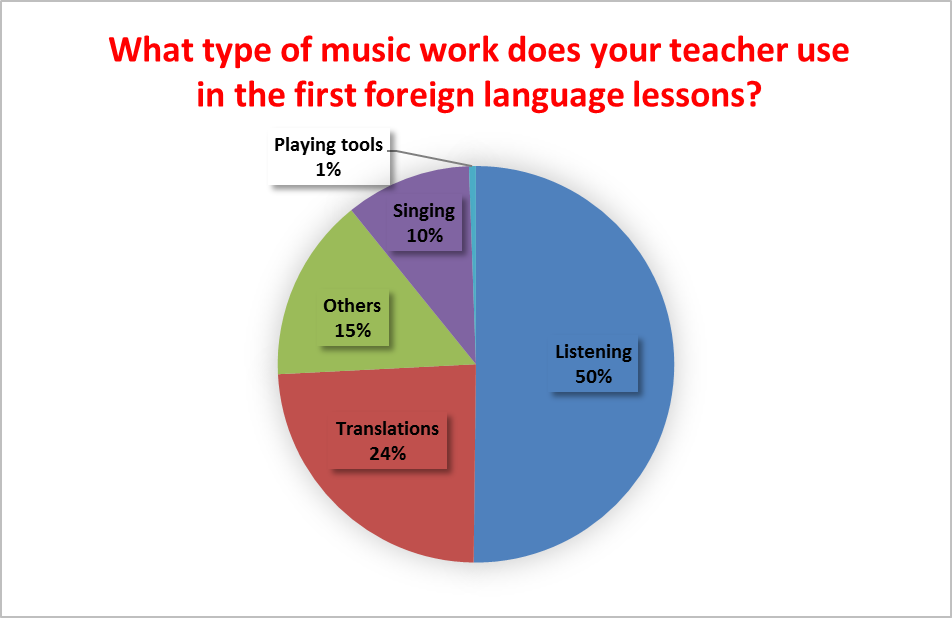
Figure
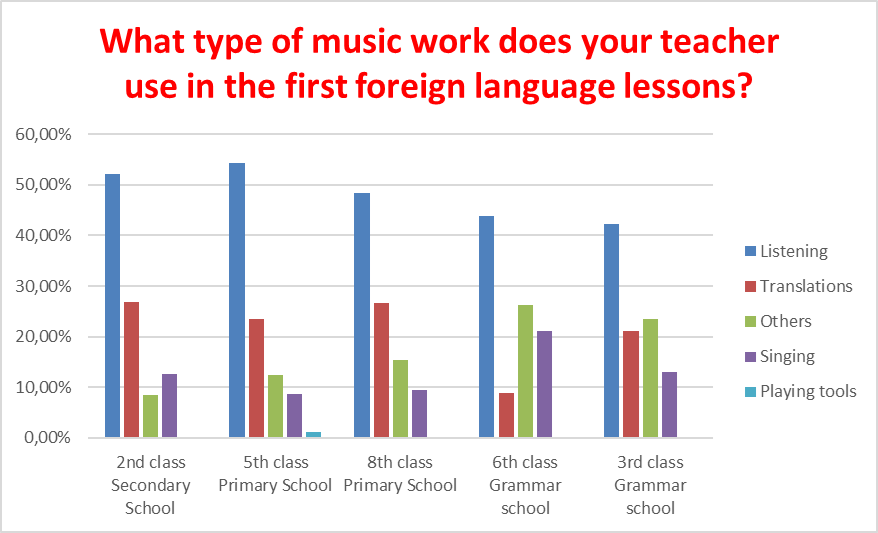
The second most frequently taught foreign language in the Czech Republic is German, which is followed by Russian, French and Spanish. The pupils were asked the same question (“Which form of applying music is preferred by the teacher?”) in connection with the second foreign language. The results were quantified and illustrated with Figure No.
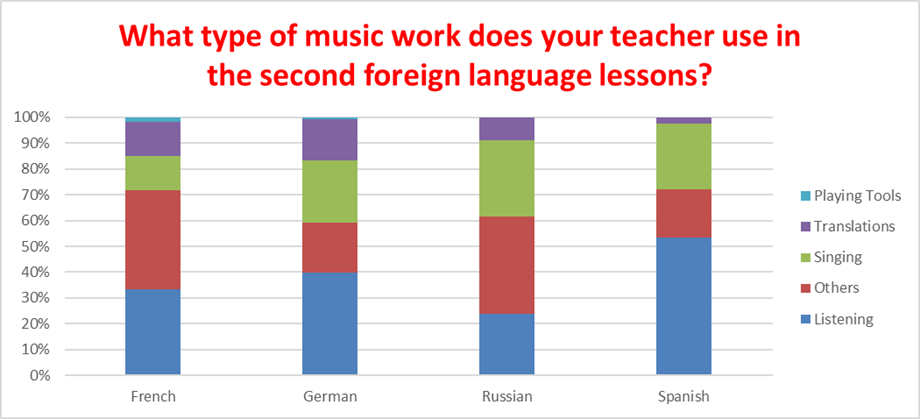
Research results
This chapter presents the results of the questionnaire survey realized to find out opinions of foreign language teachers and primary school pupils and secondary school students concerning involvement of music in foreign language teaching. Foreign language teachers´ approach to using of music in the teaching process is relatively negative; motivating or relaxing factors are considered by them as the main ones. Music is used for practising supra-segmental phenomena only sporadically. On the other hand, pupils, especially teenagers, feel a big potential of music. Music plays a big role in life of this age group. Therefore, we think that it is a pity that it is not fully used when teaching these pupils. Pupils and students feel that their teachers play music to them just as a motivating factor without any follow-up activities linked with the listened compositions. Another form of using music is translating the lyrics, which reminds us of the grammar-translation method. Quite interesting results have been brought by the research into the methods of teaching of the second foreign language in the Czech Republic. Translations of lyrics are only marginal, but listening, singing and students´ own creation are more dominant. Music is applied differently in teaching foreign languages to pupils / students of different age and of different types of schools. To conclude this part, we can say that our hypotheses stated above were fully confirmed.
Conclusion
The communicative method is prevailing in the current methodology of foreign language teaching. However, an ideal and universal method of foreign language teaching, which would enable reaching all the goals of the given teaching process actually does not exist. Selected methods used in the course of development of foreign language teaching were discussed in the text. Each of these methods has positively or negatively inspired the sphere of teaching foreign languages. The method of suggestopaedia positively supported the involvement of music into the process of foreign language teaching. This method is, in our opinion, highly inspiring. Therefore, it was characterized in a more detailed way.
Music has its justified position in the field of foreign language teaching and it deserves a bigger involvement in the teaching process applied to all age groups of learners. In 2012 an opinion poll was carried out at the Faculty of Education of the University of Hradec Králové in which students of so called University of the Third Age expressed their opinions on foreign language teaching. In case of answering the question “Which activities do you miss in your language courses held at the U3A?” respondents claimed not only for a bigger proportion of conversation activities and a more frequent repetition and practising of vocabulary, the respondents also would welcome more singing in the foreign language. (Ondráková, 2012, p. 262)
Involvement of music in foreign language teaching can be considered from several points of view, mainly that of motivation, language reception and production, emotions and support of intensive perception of language. The research realized at Czech primary and secondary schools shows that Czech teachers of foreign languages consider music mainly as a motivating or relaxing factor. Music lyrics are often used for translating activities, which rather evokes the grammar-translation method applied in the 19th century. The active applying of music, by which singing, playing musical instruments or learners´ own creation of lyrics in foreign languages is meant, is rather marginal in case of foreign language teaching in the Czech Republic. Music accompanies a human being through all his / her life; it has a formative and developmental role. Music essentially supports the complex development of a human personality. And this kind of support should be given also by the process of foreign language teaching.
References
- Altenmüller, Eckart (2012). Musikwahrnehmung und Amusien. In: Karnath, Hans – Otto; Thier, Peter (ed.): Kognitive Neurowissenschaften. Berlin: Springer-Verlag, s. 529 – 538. ISBN 978-3-642-25526-7.
- Besedová, Petra (2016). Music as an intercultural medium in foreign language teaching. In: Bekirogullari, Z., Minas, M. Y., Thambusamy, R. X. (ed.): The European Proceedings of Social and Behavioural Science Ep-SBS. Rhodes-Greek 2016, s. 646 – 662, e-ISSN 2357-1330. online: http://www.futureacademy.org.uk/publication/EpSBS/ICEEPSY_2016
- Freudenstein, Reinhold (1970). Aufgaben und Möglichkeiten der Unterrichtsmethodik, dargestellt am Beispiel des Fremdsprachenunterrichts. In: Funkkolleg Erziehungswissenschaften. Bd. 2. Weinheim: Beltz, s. 167 – 187.
- Hendrich, Josef a kol. (1988). Didaktika cizích jazyků. Praha: Státní pedagogické nakladatelství.
- Jäncke, Lutz (2012). Macht Musik schlau? Neue Erkenntnisse aus dem Neurowissenschaften und der kognitiven Psychologie. Bern: Hans Huber Verlag. ISBN 978-3-456-84575-3.
- Krumm, Hans-Jürgen (1981). Methodenlehre: Handlugsanweisungen für den Fremdsprachenlehrer. In: Zapp, Franz – Josef; Raasch, Albert; Hüllen, Werner (Hrsg.) Kommunikation in Europa. Frankfurt am Main: Diesterweg, s. 217 – 224.
- Lecanuet, Jean – Pierre (1996). Prenatal auditory experience. In: Deliége Irene; Sloboda, John (ed.) Musical beginnings. Origins and development of musical competence. Oxford: Oxford University Press, s. 3 – 34.MACKEY, William F. (1965). Language teaching Analysis. London: Longman.
- Mackey, William F. (1965). Language teaching Analysis. London: Longman.
- Maňák, Josef (2003). Výukové metody. Brno: Paido. ISBN 80-7315-039-5.
- Maňák, Josef (1997). Alternativní metody a postupy. Brno: Masarykova univerzita. ISBN 80-210-1549-7.
- Mothejzíková, Jarmila (1989-1990). K principům komunikativního vyučování IV – funkce jazyka. In: Cizí jazyky, r. 33, č. 2, s. 55 – 59.
- Mothejzíková, Jarmila (1993 – 1994). Metody výuky nejen anglickému jazyku – II. Sugestopedie. In: Cizí jazyky, č. 7 – 8, s. 248 – 252.
- Neuner, Gerhard; HUNFELD, Hans (1993). Methoden ders fremdsprachlichen Deutschunterrichts. Berlin: Langenscheidt. ISBN 978-3-468-49676-9.
- Ondráková, J. (2014) Education of Seniors at Universities of the Third Age. In: Psychology and psychiatry, sociology and healtcare, education (SGEM 2014). Sofia: Bulgaria. Step92, volume III, pp 257-264. ISBN 978-619-7105-24-7.
- Petráčková, Věra; KRAUS, Jiří a kol. (2001). Akademický slovník cizích slov. Praha: Academia. ISBN 80-200-0607-9.
- Průcha, Jan; Walterová, Eliška; Mareš, Jiří (2013). Pedagogický slovník. Praha: Portál. ISBN 978-80-262-0403-9.
- Rampillon, Ute (2000). Selbstevaluation als Auslöser konstruktiver Lernprozesse. In: Wendt, Michael (Hg.) Konstruktion statt Instruktion. Neue Zugänge zu Sprache und Kultur im Fremdsprachenunterricht. Frankfurt a/M, Berlin: Lang, s. 119 – 142. ISBN 3-361-37568-9.
- Rejzek, Jiří. (2015). Český etymologický slovník. Praha: Leda. ISBN 978-80-7335-393-3.
- Saffran, Jenny R.; GRIEPENTROG, Gregory J. (2001). Absolute Pitch in Infant Auditory Learning: Evidence for Developmental Reorganization. In: Developmental Psychology, 37, s. 74 – 85. ISSN 0012-1649.
- Siegler, Robert; DeLOACHE, Judy; EISENBERG, Nancy (2011). How children develop. New York: Worth publishers. ISBN 978-1-4292-1790-3.
- Skalková, Jarmila (1999). Obecná didaktika. Praha: ISV. ISBN 80-85866-33-1.
- Vališová, Alena (2010). Pedagogika pro učitele. Praha: Grada. ISBN 978-80-247-3357-9.
- Werker, Janet, F., Desjardins, Renée, N. (1995). Listening to speech in the 1st year of life: Experiential influences on phoneme perception. In: Current Directions in Psychological Science, Vol. 4, No. 3, s. 76 – 81.
- https://en.wikipedia.org/wiki/Maximilian_Berlitz
- http://www.multilingua.cz/zivotopis/
Copyright information

This work is licensed under a Creative Commons Attribution-NonCommercial-NoDerivatives 4.0 International License.
About this article
Publication Date
16 October 2017
Article Doi
eBook ISBN
978-1-80296-030-3
Publisher
Future Academy
Volume
31
Print ISBN (optional)
-
Edition Number
1st Edition
Pages
1-1026
Subjects
Education, educational psychology, counselling psychology
Cite this article as:
Besedová, P. (2017). Ways Of Working With Music In FLT In Primary Schools. In Z. Bekirogullari, M. Y. Minas, & R. X. Thambusamy (Eds.), ICEEPSY 2017: Education and Educational Psychology, vol 31. European Proceedings of Social and Behavioural Sciences (pp. 29-42). Future Academy. https://doi.org/10.15405/epsbs.2017.10.4

